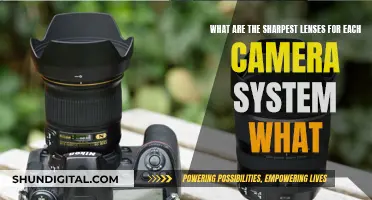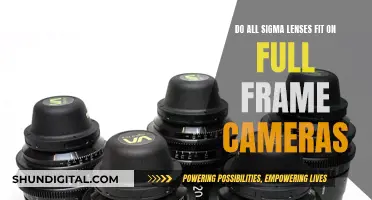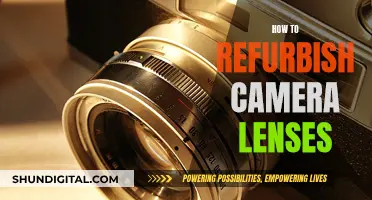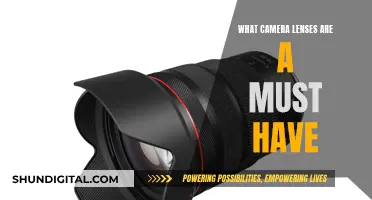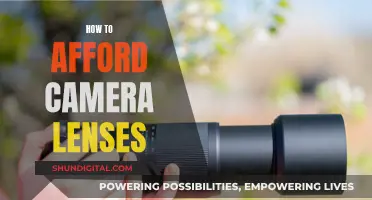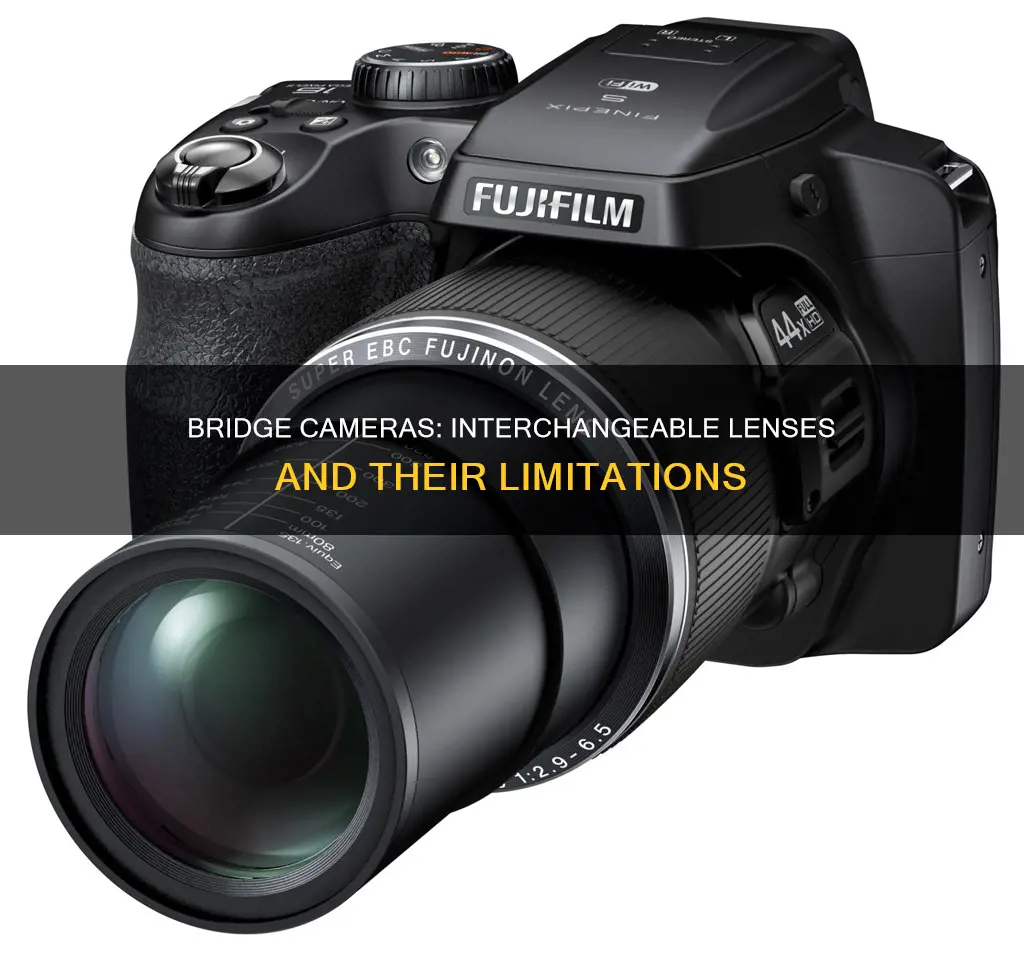
Bridge cameras are a type of camera that fills the gap between simple point-and-shoot cameras and more advanced cameras with interchangeable lenses, such as mirrorless cameras and DSLRs. They are often comparable in size and weight to DSLRs but lack interchangeable lenses. They are a good option for photographers who want a zoom range that would otherwise require carrying several lenses along with a DSLR. Bridge cameras usually have a fixed lens, a small sensor, and a wide focal range. They are a good option for beginners who want to learn more about different settings and for photographers who want a versatile camera that is easy to use and doesn't require swapping lenses.
| Characteristics | Values |
|---|---|
| Definition | Bridge cameras are so-called because they “bridge” the gap between compact cameras (or mobile phones) and more advanced compact system cameras or DSLRs. |
| History | The term was originally used to refer to film cameras which "bridged the gap" between point-and-shoot cameras and SLRs. |
| Lens | Bridge cameras feature a fixed, long zoom lens. |
| Interchangeable lenses | Bridge cameras usually do not have interchangeable lenses. |
| Manual controls | Bridge cameras have some degree of manual control. |
| Viewfinder | Almost all digital bridge cameras lack an optical viewfinder system. |
| Image sensor | Bridge cameras typically have small image sensors. |
| Image quality | Bridge cameras have lower image quality than DSLRs and mirrorless cameras, especially in low light. |
| Zoom | Bridge cameras have a wide zoom range. |
| Size | Bridge cameras are often comparable in size and weight to the smallest DSLRs. |
What You'll Learn

Bridge cameras: a happy medium
Bridge cameras are a happy medium between simple point-and-shoot cameras and more complex interchangeable-lens cameras, such as DSLRs and mirrorless cameras. They are often comparable in size and weight to DSLRs, but typically lack interchangeable lenses and optical viewfinders. The term "bridge camera" refers to how these cameras bridge the gap between the two types of cameras, offering a balance of convenience and functionality. Here are some key advantages of bridge cameras:
Image Quality and Zoom
While bridge cameras typically have smaller image sensors than DSLRs or mirrorless cameras, they still offer impressive image quality. The larger sensors in some bridge cameras, such as those with 1-inch sensors, deliver exceptional image quality and low-light performance. Additionally, bridge cameras are known for their long zoom lenses, with some models offering up to 125x optical zoom. This makes them ideal for capturing both wide-angle and telephoto shots, making them versatile for various photography genres, including wildlife, sports, and travel photography.
User-Friendly Features
Bridge cameras provide a nice balance of automatic and manual controls, making them suitable for beginners and enthusiasts. They often feature full manual control over shutter speed, aperture, ISO sensitivity, colour balance, and metering. This allows users to learn about different settings without the complexity of an interchangeable lens system. Bridge cameras also tend to have comfortable DSLR-style handling, making them easier to operate than compact cameras.
Convenience and Portability
The fixed lens on bridge cameras means you don't need to carry multiple lenses, making them a lightweight and convenient choice for photographers on the go. Bridge cameras are ideal for travellers who want a versatile camera without the hassle of lens changes. Additionally, the lack of interchangeable lenses reduces the chance of dust and dirt getting onto the sensor, resulting in cleaner images.
Affordability
Bridge cameras offer excellent value for money, providing a wide range of features and capabilities at a fraction of the cost of DSLRs or mirrorless cameras. They are a cost-effective way to get started in photography, offering a balance of functionality and ease of use.
Examples of Bridge Cameras
Some popular bridge cameras on the market include the Sony Cyber-shot RX10 IV, Panasonic Lumix FZ2000/FZ2500, Canon PowerShot SX70 HS, and Nikon Coolpix P1000. These cameras offer a range of features, such as large zoom ranges, 4K video capabilities, and DSLR-style handling, all at competitive price points.
Bigger Camera Lenses: Do They Make a Difference?
You may want to see also

Fixed lenses on bridge cameras
Bridge cameras are fixed-lens cameras that bridge the gap between point-and-shoot cameras and DSLRs. They are often comparable in size and weight to DSLRs but lack interchangeable lenses. The term "bridge camera" has been used since at least the 1980s and continues to be used today, even as digital cameras have become the norm.
Bridge cameras typically have small image sensors, allowing their lenses to be smaller than those of a 35mm or APS-C SLR lens covering the same zoom range. This makes it possible to have a very large zoom range (from wide-angle to telephoto, including macro) with just one lens. The typical bridge camera has a telephoto zoom limit of over 400mm (35mm equivalent), with some 21st-century cameras reaching up to 2000mm or even 3000mm.
Because of their fixed lenses, bridge cameras are often more affordable than DSLRs, making them a great option for beginners or those on a budget. They are also more compact and lightweight than DSLRs, making them easier to carry around and use.
While the fixed lens offers huge zoom capabilities, it also has some limitations. For example, it doesn't support macro photography, and the smaller sensor can make it harder to blur backgrounds for portraits or other types of photography. Additionally, the image sensors in bridge cameras are generally smaller than those in DSLRs or mirrorless cameras, resulting in lower resolution, reduced dynamic range, and poorer low-light performance.
Despite these limitations, bridge cameras remain incredibly useful and versatile. They are perfect for capturing wildlife, sports, astrophotography, family photos, travel photography, and animal photography. With their large zoom ranges and DSLR-style handling, bridge cameras offer a lot of power and flexibility at a more affordable price point.
RF Lenses: The Future of Mirrorless Photography?
You may want to see also

Interchangeable-lens cameras vs bridge cameras
Interchangeable-lens cameras and bridge cameras are two distinct types of cameras, each with its own advantages and use cases. Interchangeable-lens cameras, such as mirrorless cameras and single-lens reflex cameras (SLRs), offer the flexibility of swapping lenses to suit different photography needs. On the other hand, bridge cameras are known for their convenience and bridge the gap between point-and-shoot cameras and more advanced interchangeable-lens cameras.
Interchangeable-Lens Cameras
Interchangeable-lens cameras provide users with the ability to change lenses, allowing for a wide range of creative possibilities and specialised applications. These cameras are often associated with more advanced photography and give users greater control over their equipment. Interchangeable lenses can range from wide-angle lenses to telephoto lenses, each offering unique capabilities in terms of field of view, depth of field, and low-light performance. This versatility comes at a cost, as interchangeable-lens cameras and their lenses can be more expensive and bulky. Additionally, changing lenses can be cumbersome and may not be ideal for all situations.
Bridge Cameras
Bridge cameras, on the other hand, typically feature a fixed lens with a long zoom range. They are designed to be an all-in-one solution, offering a balance between convenience and functionality. Bridge cameras are often comparable in size and weight to smaller digital SLRs (DSLRs) but lack interchangeable lenses. They are known for their large zoom ranges, making them versatile for various photography scenarios, from wide-angle landscape shots to telephoto wildlife photography. Bridge cameras are also more affordable than interchangeable-lens cameras, making them attractive to hobbyists and those on a budget. However, the trade-off is that bridge cameras have smaller image sensors, which can result in lower image quality, especially in low-light conditions.
The choice between an interchangeable-lens camera and a bridge camera depends on the user's needs and preferences. Interchangeable-lens cameras offer the ultimate flexibility in lens choices but can be more expensive and complex. Bridge cameras provide a convenient, all-in-one solution with impressive zoom capabilities, making them ideal for travel, wildlife, and family photography. It's important to consider factors such as budget, desired features, image quality expectations, and intended use case when deciding between these two types of cameras.
Lenses Unlocked: Capturing Unique Perspectives and Effects
You may want to see also

Manual controls on bridge cameras
Manual controls are a key feature of bridge cameras, which are designed to bridge the gap between DSLRs and compact cameras. They offer a similar user experience and level of manual control as DSLRs.
Most current bridge cameras are digital and feature full manual controls over shutter speed, aperture, ISO sensitivity, colour balance, and metering. Generally, their feature sets are similar to consumer DSLRs, except for a smaller range of ISO sensitivity because of their typically smaller image sensor.
The manual controls on bridge cameras allow users to have more creative input over their photographs. For example, adjusting the shutter speed can help to capture fast-moving subjects without motion blur, while changing the aperture setting can affect the depth of field, allowing for more creative control over the focus of an image.
Manual controls also enable photographers to use their bridge camera in a variety of lighting conditions. For instance, adjusting the ISO sensitivity can help to reduce noise in low-light settings, while changing the white balance setting can ensure that colours are accurately reproduced in different types of lighting.
In addition to these standard manual controls, some bridge cameras also offer manual focus rings, which provide more precise control over the focus of an image. However, it is worth noting that bridge cameras typically have small sensors, which can make it challenging to achieve a shallow depth of field.
Overall, the manual controls on bridge cameras provide users with a high level of flexibility and creativity in their photography, while also offering the convenience and ease of use of a compact camera.
Olympus Lenses: Universal Fit for All Olympus Cameras?
You may want to see also

The pros and cons of bridge cameras
Bridge cameras are a good option for those looking for a camera with more capabilities than a compact point-and-shoot but who aren't ready to invest in a high-end DSLR. They are also a good option for those who want the convenience of a compact camera with the zoom of a telephoto lens and the ergonomics of a DSLR.
Pros of Bridge Cameras:
- They are generally cheaper than DSLRs.
- They provide a wide zoom capability, with a fixed lens and a massive zoom range.
- They are easy to use, especially if you have used a point-and-shoot camera before.
- They are light and easy to carry, making them appropriate for random photography in streets, nature and during travel.
- They have a range of controls similar to a less complex DSLR.
- They have manual controls over shutter speed, aperture, ISO sensitivity, colour balance and metering.
- They are a good option for beginners who want to learn the fundamentals of DSLR photography while maintaining the convenience of a compact model.
Cons of Bridge Cameras:
- They have slower shutter speeds, which can create blurred images for moving objects.
- They have inferior low-light settings compared to DSLRs.
- They have a restricted range of apertures.
- They have a single fixed lens, so they can't adjust the image quality compared to DSLRs.
- They have generally low native ISO sensitivity.
- They only have an electronic viewfinder, which can drain the battery and has limited outdoor visibility.
Camera Lenses: Reselling and Buying Used
You may want to see also
Frequently asked questions
A bridge camera is a camera that fills the gap between simple point-and-shoot cameras and more advanced cameras with interchangeable lenses, such as DSLRs and mirrorless cameras.
No, bridge cameras do not have interchangeable lenses. They have fixed lenses with a wide zoom range.
A fixed lens reduces the chance of dirt getting on your camera's sensor, which can cause spots and marks on your images. It also makes the camera easier to handle and more convenient to use.
A fixed lens means you can't attach specialised lenses like a macro lens for extreme close-ups or an f/1.4 lens for low-light photography.
Bridge cameras usually have a small sensor similar to those in compact cameras, but some newer models have larger one-inch sensors. They also typically have a full set of manual and semi-automatic modes, making them a good option for beginners and enthusiast photographers.


